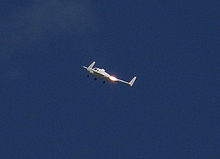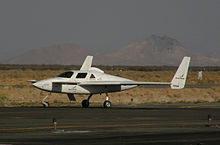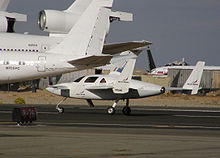- Rocket Racing League
-
Rocket Racing League Type Private Industry Air racing · Sports · Entertainment
Aerospace engineeringFounded 2005 Headquarters New York, Boston, Santa Monica, Las Cruces Key people Granger Whitelaw · Peter Diamandis
Robert Hariri · Bill Koch · Bob WeissProducts Rocketplane design, race promotions Employees 15[citation needed] Website www.rocketracingleague.com  The prototype Rocket Racer, a modified Velocity SE climbing to 10,000 feet on its first full flight, October 29, 2007 at the Mojave Spaceport.
The prototype Rocket Racer, a modified Velocity SE climbing to 10,000 feet on its first full flight, October 29, 2007 at the Mojave Spaceport.
The Rocket Racing League is a proposed racing league that would use rocket-powered aircraft to race a closed-circuit air racetrack. Founded in 2005, the league is currently working to hold the first multi-vehicle races in 2011. The "rocket racers" are to compete in the air and on a virtual racetrack easily viewed by a live airshow-type audience as well projected on large screen and handheld electronic displays.
Four prototype canard-style Rocket Racer aircraft have been built since 2001.
The league had planned to hold its inaugural race season in 2008 with four races, but encountered financial difficulties that delayed fielding of Rocket Racers by the six teams that had been previously announced. With the addition of venture capital funding in mid-2009, technology development continued and exhibition races are now occurring in 2010, with plans for an inaugural season of races in 2011.
Contents
Background
Projected to be an hour and one half in length, the races would be between proposed Rocket Racer planes that use liquid oxygen and either kerosene or ethanol fuel[1][dead link] with a burn time of four minutes. The rocketplanes are expected to cost less than US$1 million each. The planes are based on the a fixed-gear Velocity SE modified by XCOR Aerospace and the retractible gear Velocity XL modified by Armadillo Aerospace for the purpose of rocket racing. The Velocity airframe is derived from a commercially-available kit plane that traces its design heritage to the Rutan Long-EZ, which has been modified to accept rocket power and custom avionics. In order to provide the airframes, RRL purchased the aircraft's manufacturer, Velocity Aircraft, in April 2008.[2][dead link]
The RRL has been called "NASCAR with rockets", The Rocket Racer flew for a public audience at the 2008 EAA AirVenture Airshow at Oshkosh, Wisconsin.[3][4] If league competition begins, Whitelaw indicated tournament semifinals would be held each September in Nevada, with finals each October in New Mexico at the X Prize Cup competing for a $2 million championship purse.
Races would take place on a race course two miles (3 km) long, one mile (1.6 km) wide, and 1,500 feet (460 m) in the air. A typical race would take about one hour, and fans would be able to see multiple camera views, including cockpit, "on-track," "side-by-side" and wing-angle views.
Additionally, a computer game is planned which will interface with racer position data in real time over the internet, allowing players to virtually compete with the rocket pilots.
The Track
The proposed "track" for a typical Rocket Race begins with a staggered start. Pilots take off in pairs a few minutes apart, they will be competing against the clock but will maneuver around each other much like NASCAR. The pilots will be guided by a virtual three-dimensional "track" projected in their head-up display. Each racer will have a separate track to follow but the courses will be close together to build the excitement.[citation needed]
Teams
As of 2008[update], there were six teams registered to compete in the inaugural 2008 race season, Rocket Star Racing, Team Extreme Rocket Racing, Canada-based Beyond Gravity Rocket Racing, Bridenstine Rocket Racing, Santa Fe Racing and Thunderhawk Rocket Racing.[4] As of 2010[update], RRL is claiming that "official team recruitment will commence in 2010" and five "candidate teams of the RRL franchise": Bridenstine Rocket Racing, Santa Fe Racing, Rocket Star Racing, Team Extreme Rocket Racing, and Canada-based Beyond Gravity Rocket Racing.[5]
History
The formation of the league was announced by Granger Whitelaw, and Peter Diamandis, founder of the Ansari X-Prize, in October 2005[6] in partnership with the Reno Air Races.[citation needed] According to Diamandis, the purpose of the league is to "inspire people of all ages to once again look up into the sky and find inspiration and excitement."[citation needed]
Initial plans called for a four-team league finals in 2006, to be followed by 10 teams competing in 2007, with video games based on the competition also out in 2007.[6] In 2006, analysts identified doubts about the economics of the venture, and especially of the ability of RRL to attract a large fanbase similar to IndyCar and Nascar[7] In the event, no races occurred in either 2006 nor 2007.
In April 2008, the league stated that it was "ready for competition [announcing] four exhibition races will be held later [in the] year, one in Las Cruces."[8]
On April 14, 2008, the Racing Rocket Racing Composite Corporation, a subsidiary of the Rocket Racing League, acquired Velocity Aircraft. The RRL announced their goal was to "produce an airframe that will be consistent for all competing Rocket Racers."[9]
On May 26, 2010, a Velocity employee posted to the builder's email-list a note from Scott and Duane Swing that stated that they had bought back full ownership of Velocity Inc from Rocket Racing League. The RRL now owns no share of Velocity Inc.[10]
League financial difficulties
None of the four planned 2008 races were actually run. The Rocket Racing League had difficulty in attracting and retaining sufficient financial backing, from both investors and sponsors, in order to get an initial racing season firmly scheduled in 2008, 2009, or 2010. Some progress with the rocket and aircraft technology continued however.
The league twice failed to complete construction of six hangars contracted to be built on land adjacent to Spaceport America near Las Cruces, New Mexico. As of January 2009, the league was at risk of having their leases with the City of Las Cruces terminated.[11]
In July 2009, the league announced the closing of a venture capital financing round of US$5.5 million. The funds will be used for ongoing operations and for the development of a next-generation Rocket Racer.[12]
As of February 2010[update], Peter Diamandis suggested that 2010 could be the year that we see "more than one racer in the air and possibly in exhibition races." Non-exhibition "live" races may occur as early as 2011.[13] Also in February, the Tulsa Air and Space Museum and Planetarium (TASM) announced that it would partner with the Rocket Racing League to host an exhibition flight of a Rocket Racer at the QuikTrip Air and Rocket Show at Tulsa International Airport in April 2010.[14]
The Rocket Racing League announced a "2010 World Exhibition Tour" on April 24, 2010, when they unveiled their Mark-III X-racer rocket plane at the QuikTrip Air & Rocket Racing Show in Tulsa, Oklahoma. This was the first time RRL demonstrated two rocket racers in the air at the same time. The league's intent in such exhibitions is to "build up the league's fan base, in addition to perfecting operations and technologies, before the league's official launch in 2012."[15] The April event in Tulsa was the only RRL exhibition of 2010.
Rocket Racers
The Rocket Racing League has been developing prototype Rocket Racers since 2001, working with two airframe manufacturers and two rocket engine producers on four prototype aircraft to date. All four of the airframes have been of the canard configuration to more easily accommodate the rocket propulsion technology.
Mark-II and Mark-III X-Racers
As of 2010[update], the Rocket Racing League is utilizing a highly modified Velocity XL fixed-gear airframe and an Armadillo Aerospace 2,500 pound thrust liquid oxygen (LOX) and ethanol rocket engine in both its Mark-II X-Racer and Mark-III X-Racer demonstration vehicles.[16] The Mark-II and Mark-III racers can liftoff into the air in just 4 seconds after the rocket engine is ignited; both vehicles are limited to a top flight speed of 300 mph (480 km/h).[17] The rocket engine is a LOX-Ethanol, film-cooled, pressure-fed, blow-down[18] design with a 10 to 15-foot (4.6 m)-long exhaust plume. Plume-seeding technology allows the plume color to vary from red to green to yellow to better facilitate race spectators in keeping track of specific racers while in the air.[17]
The Mark-II (N205MB) racer utilizes a standard fixed-gear XL airframe, modified for the addition of the Armadillo rocket propulsion. The Mark-III (N133XP) airframe was modified during manufacturing at Velocity Aircraft explicitly for use as a rocket racer, with canopy top, center seat and control stick, and other enhancements.[16]
Predecessor aircraft
XCOR Aerospace developed the XCOR EZ-Rocket X-Racer prototype rocketplane for the Rocket Racing League. First flight was July 21, 2001 at Mojave Airport in Mojave, California.[19] This first RRL prototype was built on a Rutan Long-EZ airframe and, in its final version, utilized two 400 lbf (1.8 kN) thrust XCOR Aerospace isopropyl-alcohol-powered rocket engines[7] of engine type XR-4A3.[20] XCOR flew the EZ-Rocket for several years in development and demonstration flights, in collaboration with the RRL, including at the 2005 X-Prize Cup in New Mexico.[7]
By 2006, the design-point for the RRL racer had become a single rocket engine utilizing kerosene as the rocket fuel, carrying 250 lb (110 kg) of liquid oxygen in its flight oxidizer tank.[7]
The second RRL prototype built, known as the Mark-I X-Racer, was built on a Velocity SE airframe and was also powered by XCOR Aerospace rocket technology, a regeneratively-cooled and pump-fed XR-4K14 rocket engine.[20] This rocket-powered aircraft flew several demonstration flights at the 2008 EAA AirVenture Oshkosh air show.[21] The total thrust for the single-engine Mark-I X-Racer was variously reported as 1,500 lbf (6,700 N)[20] to 1,800 lbf (8,000 N)[7], approximately twice that of the EZ-Rocket initial prototype.
References
- ^ Rocket Racer fact sheet from League website
- ^ RRL press release announcing acquisition of Velocity.
- ^ Alan Boyle (Posted: Tuesday, July 29, 2008 6:07 PM). "Rocket racer goes public". Cosmic Log (MSNBC). http://cosmiclog.msnbc.msn.com/archive/2008/07/29/1232296.aspx.
- ^ a b Ken Denmead (August 1, 2008). "Rocket Racing League Wants to be NASCAR in the Air". Wired. http://blog.wired.com/geekdad/2008/08/rocket-racing-l.html. Retrieved 2009-10-22.
- ^ Rocket Racing League Teams, Rocket Racing League website, 2010, accessed 200-05-13. "Official team recruitment will commence in 2010. Early candidate teams of the RRL franchise include Bridenstine Rocket Racing, Santa Fe Racing, Rocket Star Racing, Team Extreme Rocket Racing, and Canada-based Beyond Gravity Rocket Racing."
- ^ a b ‘Rocket racing league’ gets its start, Alan Boyle, msnbc.com, 2005-10-03, accessed 2010-09-02.
- ^ a b c d e X-Racers, Start Your Rockets! : The creators of the X prize offer a sensational vision of rocket-powered airplanes speeding through the sky. But can their new racing league steal a bit of Nascar's thunder?, Michael Belfiore, Popular Science (feature cover story), 2006-02-15, accessed 2010-09-02.
- ^ Medina, Jose L. (2008-04-15). "Rocket league schedules Las Cruces race". Las Cruces Sun-News. http://www.lcsun-news.com/ci_8925192. Retrieved 2009-10-22.
- ^ Rocket Racing Composite Corp. Acquires Velocity Aircraft, Parabolic Arc, 2008-04-14, accessed 2011-01-03.
- ^ Swing Family Repurchase of Velocity Inc. from Rocket Racing League, Velocity Aircraft Listserve, text copy from tvbf.org archives, 2010-05-26. "For those of you wondering just what influence Rocket Racing has with Velocity, let me assure you that they have none. As I write this, the sole ownership of Velocity Inc. is now totally and completely in the hands of Scott Swing and myself. Through a stock exchange, Scott and I returned our Rocket Racing stock for 100% return of the stock they held in Velocity Inc. Rocket Racing now has 0% ownership in this company. ... Scott and Duane Swing"
- ^ Ramirez, Steve (2009-01-06). "City won't bail out of deal with Rocket Racing". Las Cruces Sun-News. http://www.lcsun-news.com/las_cruces-spaceport/ci_11384008. Retrieved 2009-10-22.
- ^ Goldsmith, Rob (2009-07-04). "Rocket Racing League Closes Multi-Million Dollar Financing". News (Space Fellowship.com). http://spacefellowship.com/2009/07/04/rocket-racing-league-closes-multi-million-dollar-financing/. Retrieved 2009-10-22.
- ^ Aero-TV: Rocket Racing League -- Diamandis Plans 2010 Exhibition Racing, Aero-News Network, 2010-02-15, retrieved 2010-02-15.
- ^ TULSA AIR AND SPACE MUSEUM ANNOUNCES PARTNERSHIP WITH ROCKET RACING LEAGUE AND INAUGURAL QUICKTRIP AIR & ROCKET RACING SHOW, 2010-02-16, accessed 2010--4-01.
- ^ Rocket Racing League Unveils New Flying Hot Rod, by Denise Chow, Space.com, 2010-04-26, accessed 2010-04-27.
- ^ a b Rocket Racing League Announces Milestone Development in X-Racer, press release, 2010-03-10, accessed 2010-05-03.
- ^ a b Flying inside the groove: the latest rocket-powered test aircraft take just four seconds to get into the air from ignition. The brink of take-off for the RRL, Aerospace Testing International, June 2010, pp. 50-54, accessed 2010-09-06.
- ^ Joiner, Stephen (2011-05-01). "The Mojave Launch Lab". Air & Space Smithsonian. http://www.airspacemag.com/space-exploration/The-Mojave-Launch-Lab.html. Retrieved 2011-03-18 (online precedes the print edition date). ""blow-down" mode: without external helium pressure, relying solely on helium pumped into the smaller internal propellant tanks [which limits] duration. "
- ^ First Flights - XCOR Aerospace, Mojave Transportation Museum, accessdate=2006-11-13
- ^ a b c Products Overview, XCOR Aerospace, undated, accessed 2010-12-27. "Twin 400 lb-thrust XR-4A3 engines aboard the EZ-Rocket" (with in-flight photograph) ... "Another engine that we have devloped in parallel is the XR-4K14, ... a 1,500 lb thrust regeneratively cooled LOX and pump-fed kerosene system ... used as the Rocket Racer aircraft's main engine."
- ^ XCOR X-Racer, by Nancy Atkinson, Universe Today, 2009-08-06, accessed 2010-04-26.
External links
- Rocket Racing League website
- video: Rocket Racing League augmented reality technology overview, official RRL release, June 2010.
- video: Rocket Racing League & Armadillo Aerospace, official RRL release, February 2010. Indicates new class of rocket engines for RRL are throttle-able.
- Rocket Racing League Closes Multi-Million Dollar Financing (Spacefellowship.com, July 2009)
- XCOR page on RRL
- Sci-fi to sky high: rocket racers set to leave Formula One in the pits (The Times, Oct. 5, 2005)
- NASCAR in the Clouds (Wired, February 2, 2006)
- X-Racers, Start Your Rockets! (Popular Science cover article, February 2006)
- RR Inc. Gets FAA Experimental Exhibition Certificate (Press Release, October 2008)
Categories:- Racing sports
- Air racing
- Rocket-powered aircraft
Wikimedia Foundation. 2010.



